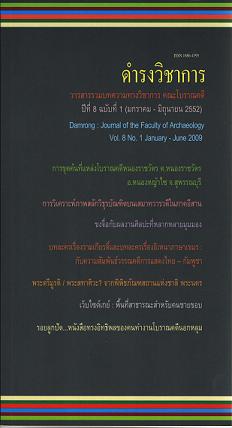TRIMURTI /SADASIVA? STATUE FROM BANGKOK’S NATIONAL MUSEUM
Keywords:
พระตรีมูรติ, ศาสนาฮินดู, ประติมานวิทยาAbstract
Hinduism during the Ayutthaya Period can trace its roots all the way back to the Ancient Khmer Empire. The Ayutthaya system of beliefs, ceremonies and style of art (especially images of the Hindu Gods) are a mixture of Ancient Khmer influences and local progressions.
Specifically, the Ayutthaya art image known as Trimurti (a combination form of three supreme Hindu gods which I use as a case study, and are exhibited at Bangkok’s national museum) is a style of art which strongly reflects the influence of Khmer art. It should be noted, however, that the style and appearance of this image is not a complete facsimile of the original Ancient Khmer example, because its iconographical illustration is more akin to another form of Siva (Isvara), known as Sadasiva, which is also highly visible in Khmer art.
References
สุภัทรดิศ ดิศกุล, หม่อมเจ้า. ทรงเรียบเรียงจากบทความของนายกมเลศวร ภัฏฏาจารย์. ศาสนาพราหมณ์ในอาณาจักรขอม. พิมพ์ครั้งที่ 3. กรุงเทพฯ: บริษัท อมรินทร์พริ้นติ้งแอนด์พับลิชชิ่ง จำกัด (มหาชน), 2547.
อรุณศักดิ์ กิ่งมณี. ตรีมูรติ อภิมหาเทพของฮินดู. กรุงเทพฯ: เมืองโบราณ, 2551.
Doniger O’Flaherty, Wendy and other. Elephanta: the cave of shiva. Princeton, New Jersey: Princeton University Press, 1983.
Huntington, Susan L. The art of ancient India: Buddhist, Hindu, Jain. New York: Watherhill, 1985.
Kramrisch, Stella. The Presence of Siva. Princeton: Princeton University Press, 1981.
McGill, Forrest and others. The Kingdom of siam: The artog central Thailand, 1350-1800. San Freacisco: Asian Art Museum, 2005.
Rao, T.A. Gopinatha. Element of Hindu Iconography Vol. II, Prt. I-II. Delhi: Motilal Banarsidass, 1968.
Downloads
Issue
Section
License
บทความนี้เป็นผลงานของข้าพเจ้าแต่เพียงผู้เดียว และ/หรือเป็นผลงานของข้าพเจ้าและผู้ร่วมงาน ตามชื่อที่ระบุในบทความจริง และเป็นผลงานที่มิได้ถูกนำเสนอหรือตีพิมพ์ที่ใดมาก่อน





